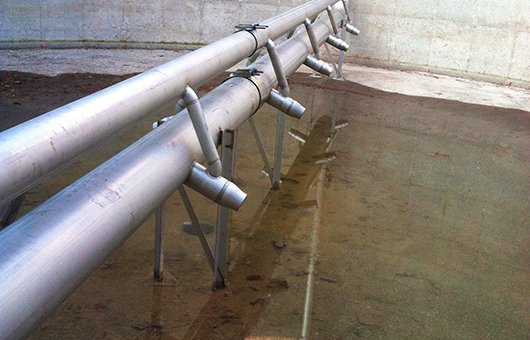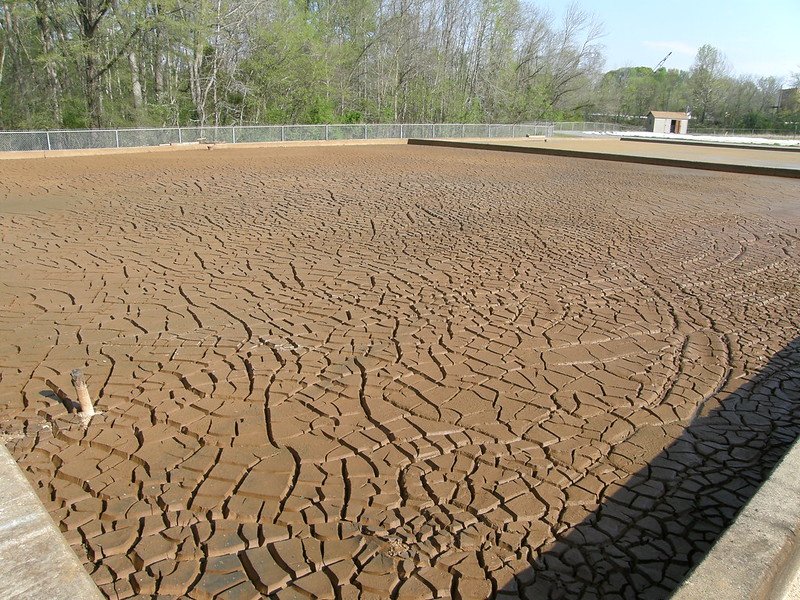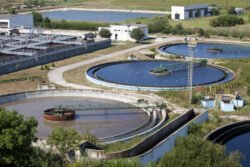Jet Aeration: Revolutionizing Wastewater Treatment Efficiency

Jet aeration is a powerful method for adding oxygen to water and wastewater. It uses high-speed water jets to mix air into liquid, creating tiny bubbles that dissolve oxygen quickly. This process is key in many treatment plants and industrial settings.
Jet aerators can boost oxygen levels in water up to 8 times faster than surface aerators. This makes them great for places that need to treat a lot of water fast. They work well in deep tanks and can handle different types of wastewater.
These systems are flexible and can be set up in many ways. Some use bidirectional jet nozzles that send water in two directions. Others use special designs to spread air evenly through big tanks. Jet aerators help keep water clean and support healthy ecosystems in treatment plants.
Key Takeaways
- Jet aeration mixes air into water using high-speed jets to increase oxygen levels
- These systems are versatile and can be used in various tank shapes and sizes
- Jet aerators are efficient and can handle high-volume water treatment needs
Principles of Jet Aeration
Jet aeration is a powerful method for adding oxygen to water. It uses high-speed water jets to mix air into liquid. This process is key for many water treatment and aquaculture systems.
Mechanics of Jet Aeration
Jet aeration works by forcing water through small nozzles at high speed. This creates a spray of tiny droplets. As the droplets move through the air, they absorb oxygen.
When the water falls back into the tank, it brings the oxygen with it. The turbulence from the jets also helps mix the oxygenated water throughout the tank.
Hydro jet aeration systems often use pumps to recirculate water. This keeps the process going without wasting water.
The size of the nozzles and the water pressure affect how well the system works. Smaller drops and higher pressure usually mean more oxygen transfer.
Comparison with Traditional Aeration Methods
Jet aeration often works better than older methods like surface aerators or diffusers. It can add more oxygen in less time.
Jet systems use less energy than many other types of aerators. This makes them cheaper to run over time.
They also take up less space in the water. This leaves more room for fish or other aquatic life.
Jet aerators are easier to adjust than some other types. You can change the flow rate or nozzle type to fine-tune the oxygen levels.
One downside is that jet systems can be louder than some other methods. They may also cost more to install at first.
Types of Jet Aerators
Jet aerators come in two main varieties: surface and submerged. Each type has unique features that make it suitable for different aeration needs in water treatment processes.
Surface Jet Aerators
Surface jet aerators operate at the water’s surface. They spray water into the air, creating a fountain-like effect. This process mixes air and water, adding oxygen to the liquid.
Bidirectional jet aerators are a type of surface aerator. They have nozzles on both sides of the liquid header. This allows water flow in two directions.
Surface jet aerators work well in large tanks. They can be circular or rectangular. Often, a single header runs down the middle of the tank.
These aerators are effective at:
- Breaking up surface scum
- Reducing odors
- Preventing mosquito breeding
Submerged Jet Aerators
Submerged jet aerators operate below the water’s surface. They use a pump to force a mix of air and water through nozzles underwater.
The jet aerator pump is a key component. It creates the pressure needed to mix air and water effectively.
Submerged jet aerators offer several benefits:
- Less affected by wind and weather
- Lower operating noise
- Reduced heat loss in cold climates
They work well in deep tanks and lagoons. Submerged jet aerators can also help prevent ice formation in winter.
These aerators create a circular flow pattern in the tank. This helps mix the contents thoroughly.
Design Considerations
Jet aeration systems require careful planning to maximize efficiency and effectiveness. Key factors include oxygen transfer, proper sizing, and material choices.
Oxygen Transfer Efficiency
Jet aerators work by mixing air and water to increase dissolved oxygen levels. The design of the nozzle and mixing chamber greatly affects oxygen transfer.
Nozzle shape and size impact bubble formation. Smaller bubbles provide more surface area for oxygen transfer.
Mixing chamber design influences contact time between air and water. Longer contact allows more oxygen to dissolve.
Water velocity through the aerator affects turbulence. Higher turbulence leads to better mixing and oxygen transfer.
Proper placement of jet aerators in tanks or basins is crucial. Spacing and depth affect overall system performance.
Jet Aerator Sizing
Sizing jet aerators correctly ensures adequate oxygenation for the application. Several factors influence sizing:
- Tank or basin volume
- Required dissolved oxygen levels
- Influent characteristics
- Temperature
- Altitude
Engineers use calculations to determine the ratio of air to water flow needed. This ratio helps size pumps and blowers.
Oversized systems waste energy. Undersized systems can’t meet oxygen demands. Proper sizing balances performance and efficiency.
Material Selection
Jet aerators face harsh conditions. Choosing the right materials is vital for durability and performance.
Nozzles and mixing chambers need wear-resistant materials. Options include:
- Stainless steel
- High-density polyethylene (HDPE)
- Ceramic
Pumps and piping must resist corrosion. Stainless steel or plastic materials work well.
Seals and gaskets require chemical-resistant elastomers. This prevents leaks and ensures long-term operation.
Consider maintenance needs when selecting materials. Easy-to-clean surfaces and replaceable parts reduce downtime.
Applications of Jet Aeration
Jet aeration systems offer versatile solutions for oxygenating water in various settings. These systems use high-pressure jets to mix air and water efficiently, providing benefits across multiple industries.
Wastewater Treatment
Jet aerators play a crucial role in wastewater treatment plants. They introduce oxygen into wastewater, supporting bacterial growth that breaks down organic matter. This process helps purify water before its release into the environment.
Jet aeration systems can handle high organic loads and varying flow rates. They’re often used in oxidation ditches and aeration basins. These systems create a circular flow pattern, ensuring thorough mixing and oxygen distribution.
The flexibility of jet aerators allows for easy adjustment of oxygen levels. This helps maintain optimal conditions for biological treatment processes. Jet aeration also reduces odors and improves overall treatment efficiency.
Aquaculture
In fish farming, jet aeration systems maintain healthy oxygen levels for aquatic life. They’re particularly useful in high-density aquaculture operations where oxygen demand is high.
Jet aerators create water currents that distribute oxygen evenly throughout ponds or tanks. This helps prevent dead zones where oxygen levels might drop dangerously low. The water movement also helps disperse fish waste and uneaten feed.
These systems can be adjusted to meet changing oxygen needs as fish grow. They’re effective in both freshwater and saltwater environments. Jet aeration in aquaculture leads to better fish health, faster growth rates, and increased production.
Hydroponic Systems
Hydro jet aeration enhances plant growth in soilless cultivation systems. It delivers oxygen directly to plant roots, promoting healthier and more robust growth.
In hydroponic reservoirs, jet aerators prevent water stagnation. This reduces the risk of root diseases and algae growth. The constant movement of nutrient-rich water ensures all plants receive adequate nutrition.
Jet aeration in hydroponics improves nutrient uptake by roots. It also helps maintain stable pH levels in the nutrient solution. This leads to faster plant growth, higher yields, and better crop quality in hydroponic farming operations.
Advantages and Limitations
Jet aeration offers unique benefits and challenges in water treatment. Its performance depends on various factors that affect efficiency, upkeep, and environmental impact.
Energy Efficiency
Jet aerators can be highly energy-efficient in certain conditions. They use less power than some other aeration methods for the same oxygen transfer rate. This saves on electricity costs.
Jet aerators work well in deep tanks. They can push air bubbles further down, improving oxygen use. This makes them good for treating high-strength wastewater.
But efficiency can vary. It depends on tank depth, water quality, and system design. Shallow tanks may not be ideal for jet aeration. The wrong setup can waste energy.
Maintenance Requirements
Jet aerators need regular care to work well. The nozzles can get clogged with debris or mineral buildup. This reduces air flow and oxygen transfer.
Cleaning nozzles is a common task. It may need to be done weekly or monthly. The frequency depends on water quality and usage.
Jet aerator pumps have moving parts that wear out. They need checks and repairs. This can add to operating costs.
But jet aerators have fewer parts than some other systems. This can make overall maintenance simpler. Proper care extends the life of the equipment.
Environmental Impact
Jet aeration can help protect the environment. It treats wastewater effectively, reducing pollution in rivers and lakes.
The process creates less noise than surface aerators. This is good for areas near homes or wildlife.
Jet aerators mix water well. This prevents dead zones where harmful bacteria can grow. It helps maintain healthy aquatic ecosystems.
But there are some concerns. Fine air bubbles can cause foam on the water surface. This may look bad and affect wildlife.
Energy use is a factor too. While often efficient, jet aeration still needs power. Using renewable energy can help reduce its carbon footprint.
Installation and Operation
Jet aeration systems require careful setup and ongoing management for optimal performance. Proper installation and operation are key to ensuring efficient wastewater treatment.
Installation Procedures
Jet aeration installation begins with site preparation. The treatment tank must be cleaned and inspected for damage. Next, technicians mount the jet aerators securely to the tank walls or floor.
Piping systems are then connected to supply air and water to the jets. This includes installing air blowers, water pumps, and associated valves and controls. Proper sizing of equipment is crucial for system efficiency.
Electrical connections are made to power the blowers, pumps, and control systems. Wiring must comply with local codes and safety standards.
Finally, technicians calibrate sensors and control systems. This ensures proper monitoring of dissolved oxygen levels, flow rates, and other key parameters.
Operational Guidelines
Daily operation of jet aeration systems involves monitoring several factors. Operators check dissolved oxygen levels regularly, adjusting air flow as needed. They also monitor wastewater flow rates and adjust jet operation accordingly.
Regular maintenance is essential. This includes cleaning jets to prevent clogging, inspecting piping for leaks, and servicing blowers and pumps. Operators should keep detailed logs of all maintenance activities.
Water quality testing is performed frequently. Results help operators fine-tune the system for optimal treatment. Parameters like BOD, TSS, and ammonia levels are typically monitored.
Troubleshooting is an important skill for operators. Common issues include reduced oxygen transfer, uneven mixing, and equipment malfunctions. Quick identification and resolution of problems helps maintain treatment efficiency.
Maintenance and Troubleshooting
Proper care of jet aerator systems involves routine upkeep and quick problem-solving. Regular checks and cleaning keep the system running smoothly. When issues arise, a step-by-step approach helps pinpoint and fix problems fast.
Routine Maintenance
Jet aerator pumps need regular care to work well. Clean the pump’s intake screen weekly to remove debris. Check the pump’s impeller monthly for damage or clogs. Lubricate moving parts as the maker suggests.
Test water quality often. This helps spot issues early. Clean the diffuser every few months to prevent buildup. Inspect hoses and pipes for leaks or wear.
Keep a log of all maintenance tasks. This helps track the system’s health over time. Replace worn parts promptly to avoid bigger problems. Follow the maker’s guide for yearly service checks.
Troubleshooting Common Issues
When jet aerators act up, check these common problems first:
- Low oxygen levels: Clean clogged diffusers or fix air leaks.
- Unusual noise: Look for loose parts or debris in the pump.
- Weak water flow: Clear blockages or clean the intake screen.
If the pump won’t start, check the power source and fuse. Make sure the impeller moves freely. For odd smells, clean the system to remove buildup.
Test water after fixing issues to ensure proper aeration. If problems persist, consult the manual or call a pro. Quick action often prevents small issues from becoming big headaches.
Innovations in Jet Aeration Technology
New designs and eco-friendly methods are changing jet aeration systems. These advances aim to boost efficiency and reduce environmental impact.
Emerging Designs
Jet aeration technology is evolving rapidly. Engineers have created new jet aerator models that use less energy. These designs mix air and water more effectively.
One key innovation is the multi-stage jet aerator. It uses a series of jets to create a cascading effect. This improves oxygen transfer and reduces power needs.
Another breakthrough is the micro-bubble jet system. It produces tiny air bubbles that stay in the water longer. This leads to better oxygenation and less energy use.
Smart controls are also enhancing jet aerators. They adjust air flow based on real-time water quality data. This optimizes performance and saves power.
Sustainable Practices
Jet aeration is becoming more eco-friendly. Makers are using greener materials and methods to build these systems.
Some companies now offer jet aerators made from recycled plastics. This cuts down on new plastic production and waste.
Solar-powered jet aerators are gaining popularity. They use clean energy to run, reducing reliance on fossil fuels.
Biomass-derived fuels are being tested for jet aeration pumps. These fuels come from plant waste and could lower carbon emissions.
Water reuse systems are being integrated with jet aerators. They clean and recycle water, saving this vital resource.
Regulations and Standards
Jet aeration systems must follow strict regulations and industry standards to ensure safety and effectiveness. These guidelines cover equipment design, installation procedures, and operational protocols.
Industry Standards
Jet aeration equipment must meet specific design criteria. The American Society of Civil Engineers sets benchmarks for wastewater treatment systems. These standards outline proper sizing, materials, and performance metrics for jet aerators.
Many manufacturers follow ISO 9001 quality management standards. This ensures consistent production and reliable equipment. The Water Environment Federation also provides guidelines for jet aeration system design and operation.
Regular testing and certification are required. Third-party labs verify equipment performance. They check oxygen transfer rates and energy efficiency. This data helps operators choose the best systems for their needs.
Safety and Compliance
Safety is a top priority in jet aeration. The Occupational Safety and Health Administration (OSHA) sets rules for worker protection. These cover proper equipment handling and maintenance procedures.
Operators must complete safety training programs. They learn about potential hazards and emergency protocols. Personal protective equipment is mandatory when working with jet aerators.
Environmental regulations also apply. The Clean Water Act sets limits on effluent quality. Jet aeration systems must help facilities meet these standards. Regular water quality testing is required to ensure compliance.
Noise control is another important factor. Local ordinances may limit noise levels from aeration equipment. Manufacturers design systems to minimize sound output while maintaining efficiency.
Frequently Asked Questions
What determines the cost of installing a jet aeration septic system?
The cost of a jet aeration septic system depends on several factors. These include the size of the property, soil conditions, and local regulations. The number of bedrooms in a home also affects the system size and cost.
Labor and material expenses vary by location. Some areas may require additional permits or inspections, adding to the overall price.
How does a jet aeration system function in wastewater treatment?
Jet aeration systems mix air and wastewater to promote bacterial growth. They use a pump to force water through a venturi nozzle, creating a vacuum that draws in air.
This process adds oxygen to the wastewater, helping beneficial bacteria break down organic matter. The aerated mixture then flows into a settling chamber where solids separate from the liquid.
What are the maintenance requirements for a jet aerator in a septic system?
Regular maintenance is key for jet aerators. Pumps and air intakes need periodic cleaning to prevent clogs. Filters should be checked and replaced as needed.
The system requires annual inspections by a professional. They check for proper operation and may adjust air flow or clean components.
How does the performance of a jet aerator compare with other aeration methods?
Jet aerators often provide more efficient oxygen transfer than other methods. They create smaller bubbles, increasing the surface area for oxygen absorption.
These systems can handle varying loads well. They adapt to changes in wastewater volume and strength better than some alternatives.
What are the advantages of using jet aeration for wastewater treatment?
Jet aeration offers several benefits. It provides thorough mixing of wastewater and oxygen, leading to effective treatment. The systems are compact, making them suitable for small spaces.
They work well in deep tanks, where other aeration methods might struggle. Jet aerators also tend to have lower operating costs compared to some alternatives.
Where can I find a reliable distributor for jet aerator equipment?
Reliable distributors can be found through industry associations and trade shows. Many manufacturers have lists of authorized dealers on their websites.
Local wastewater treatment professionals often have recommendations. It's important to choose a distributor with a good reputation and after-sales support.


